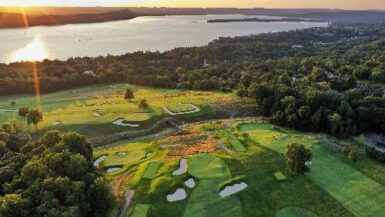So as I sit here getting organized for my trips to Cali and Pinehurst, I came up with a new term of art in describing golf course design that I think is important. I call it “architectural echo.”
“Architectural Echo” means two different but equally important elements of a golf course.
First, its the ability of a course or designer to take strategic or tactical design elements (biarritz greens, redan holes, punchbowls, alternating shot requirements, etc.) and incorporate them into the course, making them relevant to the twenty-first century.
E.g. Brian Silva’s Black Rock in Boston has a great sense of architectural echo because not only does it feature a true redan, biarritz greens, and a punchbowl green, making it true to the design concepts of the great masters, but these features flow beautifully with the land so that the course resonates with players in the present. Links at Erie Village in Syracuse has very little architectural echo because every single hole is so narrow you have to walk down them single file, there are no strategic options… (you hit this target, then that target, then the next target…hit it where I tell you only), and it has no stylized features such as qa biarritz green or a redan or anything to make the design more interesting or playable.
Second, it is the ability of a course to maintain a higfh level of player and critic popularity over time. E.G. Caledonia has an a amazing sense of architectural echo since it was infinitely popular when it opened and it has grown even more in popularity since. sawgrass has an enormous sense of architectural echo since (even a few touring pros didnt like it at first) it resonated strongly from its opening abnd has gathered unstoppable momentum since.
Here is the article I posted at a former site:
Two architectural notes today. I coined a term that seems to be catching on. I call it architectural echo. Its the ability of a golf course to resonate over time on two important ways. First, the course takes old architectural design features and brings them forward into the present so that they diversify the course design and make them relevant and enjoyable. Second, the course becomes more respected and revered over time. I got the idea from some one saying that great ideas and people echo in eternity. Its true of golf design too.
Example: Brian Silva courses have a great sense of architectural echo in that they feature saddle greens, punchbowls, redans, biarritzes, etc., and they are enjoyed and respected in the present.
Also, Coeur D’Alene in Idaho does not have old school features, but still has great architectural echo in that is been widely popular since opening and has grown in respect in popularity ever since.
By contrast, lets examine an RTJ course – Kaluyihat in Utica. Kaluyihat opened with a $125 price tag and industry wide praise, then in one mere year, plummeted in rankings so as to be off the radar screen. Its has no palpable old style features to make in more interesting than any other “bowling alley” course. Hence its sense of echo has proven to be minimal.
Lastly, with apologies to Dan Maples (you’re excluded here and I’ll buy you a drink!):
Hating blind shots is for chumps. There is nothing to fear or be lazy about. Trust your swing and your target, swing smooth and hit it. You’ll have a huge advantage over your lazy, frightened and preconditioned buddies. Besides, how much fun is it to stand on a tee box and have Dye, Strantz, Engh or any other great designer pointing you at a church steeple, clock tower or other distant landmark and screaming at you to “Hit it here.” Golf is not a game of perfect, but its also not a game of easy. Challenge yourself and you will get better.
Nobody has a problem at all with the blind shots at Lahinch, ballybunion, Prestwick, The Old Course…but bring them to the US and the designer better have earplugs and a bulletproof ego. Instead of crying like Nancy Kerrigan, get tough and swing smooth. You will surprise yourself.





Leave a reply
You must be logged in to post a comment.